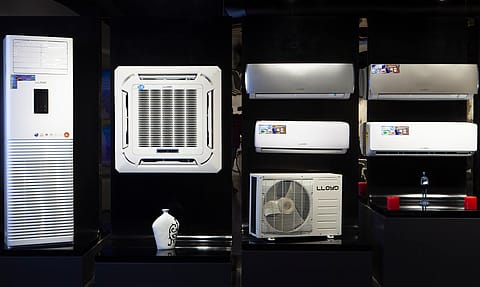GST reform to cut appliance, FMCG costs by Diwali, set to boost festive demand
The move is expected to immediately impact consumer durables, especially air conditioners, refrigerators, and televisions, where affordability has long been a barrier.

Prime Minister Narendra Modi used his Independence Day address to announce what industry had long been pushing for: a rationalisation of the goods and services tax (GST). By Diwali this year (October 21, 2025), the government will likely roll out a major round of reform that collapses the complex slab structure into fewer rates, with most items in the 28% bracket moving to 18% and those at 12% shifting to 5%.
The move is expected to immediately impact consumer durables, especially air conditioners, refrigerators, and televisions, where affordability has long been a barrier.
According to Nomura, air conditioners and televisions larger than 32 inches, currently taxed at 28%, could move to 18%, implying an effective 8% price cut for consumers. This would help clear excess inventory in the market while stimulating demand.
“GST reduction from 28% to 18% on ACs can help to make it more affordable to masses and improve the quality of life for many Indians,” said Kamal Nandi, business head and EVP, Appliances Business, Godrej Enterprises Group.
Nandi added that with AC penetration still at 9–10% in India, lower tax rates could open the market to first-time buyers. He also pointed out that refrigerators, washing machines, and microwaves — already at 18% GST — could see additional adoption with the rationalisation. “Depending on the final announcements, we expect a shift in mass and premium segments both, bringing in more first-time consumers as well as easing upgrades,” he said.
Industry players are preparing to pass on the benefits. Avneet Singh Marwah, CEO of Super Plastronics (licensee of Thomson, Kodak, Blaupunkt in India), said, “We will pass on all the benefits of the GST cut to consumers so that there is a spike in demand. Television and other categories will be more affordable, and we will update the prices immediately through our retailers.” He expects demand in cooling categories to surge next summer, with AC penetration at just 8% and air coolers at 5%.
Meanwhile, consumers can also expect direct benefits.
Recommended Stories
“A potential rationalisation from 28% to 18% for categories such as air-conditioners and other home appliances would translate into a direct market price reduction of nearly 6–7% since GST is levied on the base price. This shift could bring down consumer costs by ₹1,500–₹2,500 per AC unit, depending on the model,” said Manish Sharma, chairman, Panasonic Life Solutions India.
Analysts believe the reform will be a timely boost ahead of the festive season. A Motilal Oswal report highlighted that consumer staples, automobiles, cement, hotels, retail, consumer durables, logistics, and quick commerce will be among the biggest beneficiaries. Key stock plays likely to gain include Hindustan Unilever, Britannia, Maruti Suzuki, Voltas, Amber, Ultratech, LemonTree, Swiggy, and HDFC Bank.
Nomura noted that the timing of the reform, amid weak consumption demand, would help revive consumer sentiment. However, it cautioned that with new BEE norms for ACs coming into effect from January 2026 — raising product costs by 3–5% — the net benefit to consumers would narrow. Even so, analysts expect demand momentum to hold, particularly for companies such as Voltas, which derives 69% of revenues from ACs, and Havells, where ACs contribute 24%.
The impact won’t be limited to durables; FMCG firms will also reap benefits. A Nuvama report, for instance, showed, 70% of Bikaji’s business (ethnic snacks) is taxed at 12%, Emami has nearly 60% of its portfolio in the 12% bracket, and Dabur has 24% of its India business—Hajmola, Pudin Hara, juices, and others—at 12%. If the slab is eliminated, moving products to 5%, companies could pass on value to rural consumers or encourage premium upgrades in cities.
“The proposed GST rationalisation is a welcome step for the FMCG sector and overall consumption,” said Krishna Khatwani, head of Sales (India), Godrej Consumer Products Ltd. “In urban centres, we could see consumers upgrading more easily to premium formats. In rural areas, companies would look to pass more value to their customers through lower price points or higher volumes. This could accelerate trials and adoption, thereby improving volume growth for the FMCG sector.”
Retail and lifestyle brands are equally optimistic. “The reduction of slabs to 5% and 18% makes premium products more accessible for consumers and gives an opportunity to brands like Swiss Military to serve the evolving aspirations of Indian consumers,” said Anuj Sawhney, MD, Swiss Military Consumer Goods. He pointed out that the change could accelerate aspirational consumption in Tier II and III cities, particularly in categories like smartwatches, audio devices, and travel gear.
Consumption demand has been weak through the year, and the festive season will be the first real test of sentiment. Nomura called the reform “a much-needed boost” for households facing stagnant incomes and high borrowing costs.
“The proposed reduction in GST rates is expected to significantly boost sales during the upcoming festive season for consumer durables and FMCG products,” said Achal Chawla, Indirect Tax Partner, EY India. He advised companies to plan stock and pricing carefully to capture demand.
The GST Council is expected to approve the shift in the coming weeks, with a new 40% slab reserved for sin goods such as cigarettes. Analysts don’t expect sharp hikes here, given the focus on curbing illegal trade rather than raising tax rates.
If the Council signs off, the GST rejig could become the biggest tax change since its launch in 2017. The test will be how much of the relief companies pass on, and how quickly consumers respond.